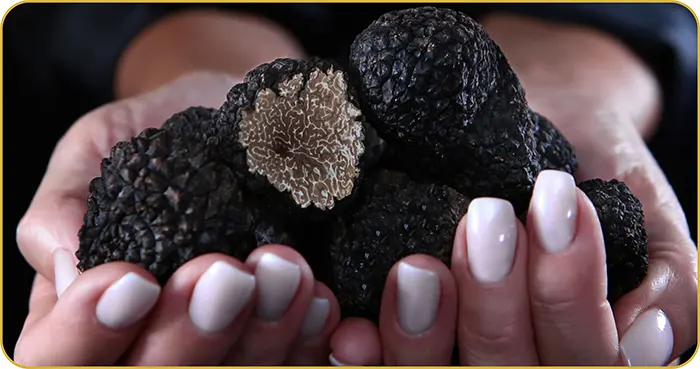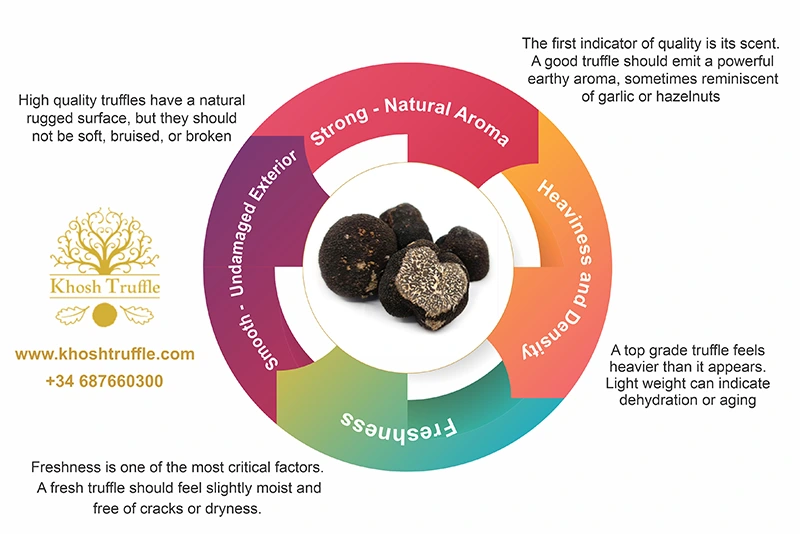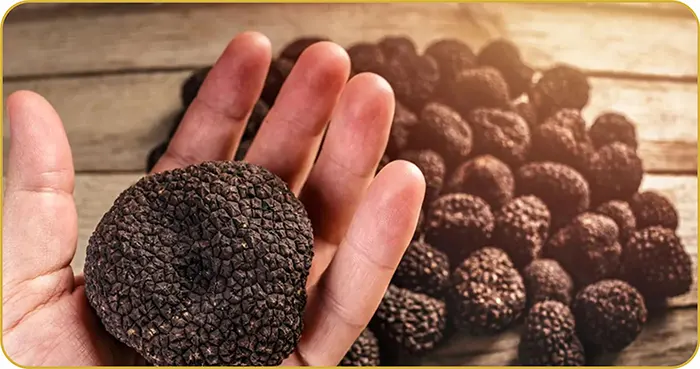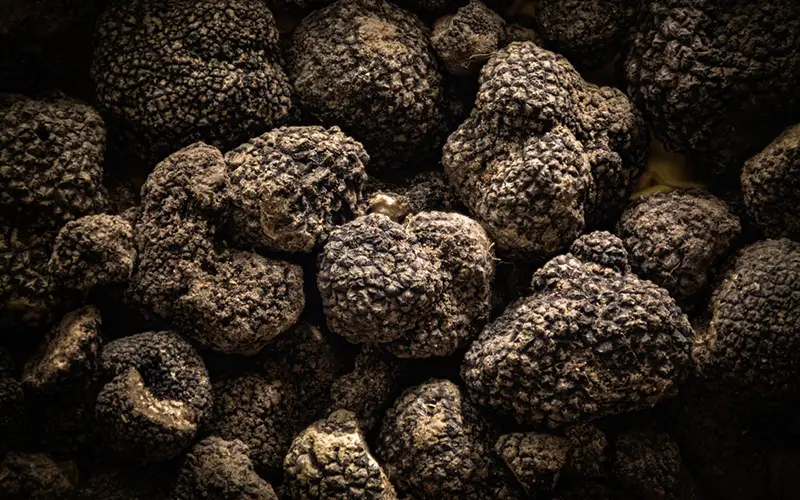Assessing Truffle Quality: Black truffles are among the rarest delicacies in the world. If you’re planning to buy this precious mushroom, understanding how to assess truffle quality is essential for making a smart and satisfying purchase.
In this article, you’ll learn how to identify high quality truffles, key tips when shopping, and how to check for freshness.
At Khosh Truffle, we offer only the finest and highest quality products. If you have any questions, feel free to reach out to us through our contact channels.
Why Is It Important to Assess Truffle Quality?
Due to their high price, truffles are often imitated or sold in lower quality. Without proper knowledge, you could spend a large sum without experiencing the authentic taste and aroma of real truffles.
That’s why recognizing the signs of a premium truffle is a must. But how can you do that?
Visual Inspection: What to Look For
When selecting truffles, appearance is a key indicator of quality. High grade truffles should have a smooth and intact surface, free of cracks, cuts, or irregular blemishes.
Color is another important clue black truffles should be dark and uniform, while white truffles should have a clear, light hue. While size can affect value, quality isn’t determined by size alone. It’s crucial to evaluate all visual aspects.

Using Aroma to Identify Premium Truffles
The aroma of a truffle is one of the best ways to determine its quality. First class truffles emit a strong, earthy, and captivating scent often reminiscent of damp soil, fresh mushrooms, and mild spices.
Bring the truffle close to your nose and inhale deeply; a rich and persistent aroma indicates freshness and authenticity. A weak or off putting smell usually signals that the truffle is old or of inferior quality.
Texture and Weight: Evaluating Quality by Touch
Touch is another reliable way to assess truffle quality. Fresh truffles are firm and resilient. When held, they should feel heavier than they look.
With gentle pressure, a quality truffle should offer balanced resistance not too soft, not too hard. The interior should also be uniform without soft or spoiled areas this consistency reflects both freshness and health.
Key Signs of a High-Quality Truffle
Let’s summarize the core characteristics of a premium truffle:
- Strong, Natural Aroma
The first indicator of quality is its scent. A good truffle should emit a powerful, earthy aroma, sometimes reminiscent of garlic or hazelnuts. If the aroma is weak or artificial, the truffle is likely old or low grade. - Smooth, Undamaged Exterior
High quality truffles have a natural, rugged surface, but they should not be soft, bruised, or broken. The color should be even, without white spots or light brown patches. - Heaviness and Density
A top grade truffle feels heavier than it appears. Light weight can indicate dehydration or aging. - Freshness
Freshness is one of the most critical factors. A fresh truffle should feel slightly moist and free of cracks or dryness. The aroma is also stronger in the days immediately following harvest.

Key Tips When Buying Truffles
Buy from Trusted Sellers
Purchasing from reputable specialty stores or well known brands like Khosh Truffle increases your chances of receiving authentic, high quality products. Need help? Contact us for personalized advice.
Check for Labels and Certifications
In many countries, premium truffles come with certifications like “organic product” or regional origin. These labels are indicators of authenticity and quality.
Know the Harvest Season
Each variety of black truffle has its own harvesting season. Being aware of this can help you identify whether the product is in season and likely to be fresh.
Understanding Truffle Types and Their Impact on Quality
Truffle quality is greatly influenced by the variety. French black truffles, Italian white truffles, and summer truffles each have their unique flavor, aroma, and price points.
Knowing the differences between these types helps you make a more informed decision when assessing quality. Learn more in our detailed article on Types of Truffle Mushrooms.

Fresh vs. Processed Truffles
Some people opt for canned or frozen truffles. While these options may be more budget friendly, they lack the aroma, taste, and overall quality of fresh truffles. If quality matters to you, always choose fresh truffles.
Proper Storage and Its Role in Maintaining Truffle Quality
Even the finest truffles will lose their aroma and flavor quickly if not stored properly. Black truffles are extremely delicate, and exposure to high humidity or open air can lead to rapid spoilage.
To learn how to preserve their quality and freshness, check out our article:
Black Truffle Storage Guide
Conclusion
Assessing truffle quality is a skill that comes with attention, knowledge, and experience. By evaluating a truffle’s appearance, scent, texture, and freshness, you can make an informed purchase and enjoy the true luxury of this gourmet ingredient.
If you’re looking for a rich and unforgettable truffle experience, always focus on quality.
Frequently Asked Questions About Assessing Truffle Quality
- How can I tell if a truffle is fresh?
Fresh truffles have a strong, natural aroma, are slightly moist, and have a firm texture. They feel heavy for their size and show no signs of cracking or dryness. - What are the signs of a fake or low-quality truffle?
Fake truffles usually have a weak or artificial smell, an unnaturally smooth surface, and feel too light for their size. - Where can I buy authentic truffles?
Specialty stores, trusted brands, and certified websites like Khosh Truffle are the best places to buy genuine, high quality truffles.

